[Herald Interview] Transforming Korea’s traditional arts
Musical ‘Story of Kim Duk-soo’ looks back on percussionist’s career of more than 60 years
By Im Eun-byelPublished : May 19, 2020 - 17:08

Since the age of 5, percussion master Kim Duk-soo has dedicated his life to Korea’s traditional performing arts. Now, more than 60 years later, his dedication is as strong as ever.
Kim, 67, is the founder of “samulnori,” a new school of traditional Korean music. Having its origins in the art of “pungmul,” an outdoor Korean traditional folk music genre, samulnori employs the jing (medium-sized gong), buk (barrel drum), kkwaenggwari (hand-held gong) and janggu (hourglass-shaped drum).
Though samulnori faced some criticism from within the local traditional arts scene at its birth in 1978, the genre took root -- so much so that many younger people believe it is a centuries-old tradition.
Though the four basic percussion instruments may seem “rather plain,” Kim believes they are the truest emblems of the musical history of the Korean Peninsula.
“The four instruments are mineral-, animal- and plant-derived. That shows us a lot about where our ancestors lived and how they lived, because musical instruments are often made with the most abundant resources around people,” Kim said during an interview with The Korea Herald on Thursday at the Sejong Center for the Performing Arts in Gwanghwamun, central Seoul.
“Samulnori is also a reflection of the rhythm of the Korean language. The musical rhythm is similar to how we speak,” the percussionist said. “But even those who do not speak Korean can relate to the music because they can sense the nuance. We can understand the emotions beneath the words even if we do not understand the language. It is the same for music.”
When talking about how samulnori can rock the world, Kim was speaking from his own experience. Kim and his music ensemble have traveled around the world showcasing samulnori, educating others and collaborating with musicians specializing in other genres.
For Kim, creating samulnori was about turning an auditory experience into a visual one. While the art of folk music has its origins in yards within villages, both villages and yards became lost concepts after industrialization. The performing arts had to be brought indoors.
That is why he chose the four percussion instruments -- for a “complete transformation.” The four instruments were fundamental to the community music traditions of Korea. Though there may be variations in the form that performances took from region to region, the four instruments were common to all regions.
“While pungmul was a more of a visually focused show, samulnori is an auditory music experience,” the music master said. “It is a creative adaptation of succeeding traditional Korean art.”
While the traditional Korean arts scene continues to be neglected by the mainstream, Kim said, there needs to be some creative adaptation of existing traditional Korean arts.
“There are millions of choices a person can make for cultural activity. We should think about where our traditional culture stands now,” Kim said.
Kim debuted at the age of 5, joining a small street-performance troupe called a “namsadang” that his father was part of. In Kim’s words, he became a “clown,” and his father was also a clown.
To this day, Kim continues to appear onstage, introducing the art of samulnori to a wider audience. But as he sees it, one of his most important tasks is education.
“The standard of a clown and an entertainer depends on the culture and era,” he said. “An entertainer is an artist who laughs and cries with the people. The life of an artist is the continuance of education and performance. Over time, I am naturally focusing on how to theorize this concept of ‘sinmyeong,’” he said.
Sinmyeong refers to a uniquely Korean sentiment that is similar to exhilaration.
Meanwhile, Kim’s life will be brought to the stage in the form of musical theater piece “The Story of Kim Duk-soo,” which runs May 28-31 at the Sejong Center.
The biographical musical, jointly produced by the Chung Mong-Koo Foundation and the Sejong Center, looks back on Kim’s lifelong journey onstage.
Due to lingering fears of the coronavirus, the state-funded Sejong Center will leave every other seat empty in compliance with the government’s “audience distancing” policy.
The musical is free of charge, but online reservations are required and will be granted on a first-come, first-served basis. For more information, check the Sejong Center’s website at sejongpac.or.kr/eng.
By Im Eun-byel (silverstar@heraldcorp.com)








![[Kim Seong-kon] Democracy and the future of South Korea](http://res.heraldm.com/phpwas/restmb_idxmake.php?idx=644&simg=/content/image/2024/04/16/20240416050802_0.jpg&u=)








![[KH Explains] Hyundai's full hybrid edge to pay off amid slow transition to pure EVs](http://res.heraldm.com/phpwas/restmb_idxmake.php?idx=652&simg=/content/image/2024/04/18/20240418050645_0.jpg&u=20240418181020)

![[Today’s K-pop] Zico drops snippet of collaboration with Jennie](http://res.heraldm.com/phpwas/restmb_idxmake.php?idx=642&simg=/content/image/2024/04/18/20240418050702_0.jpg&u=)